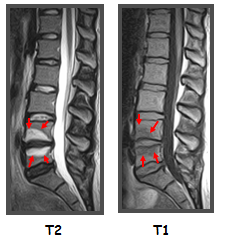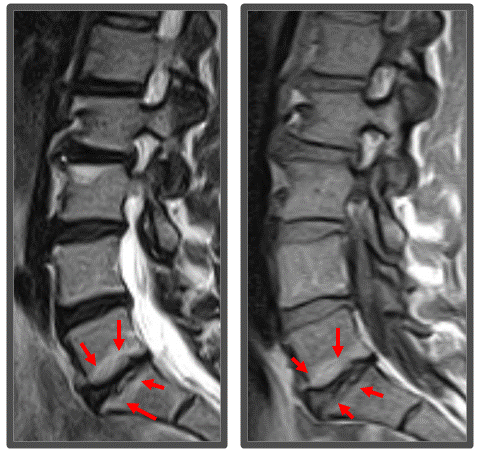Modic change refers to pathological alterations within the vertebral bone structure. The condition is named after Dr, Michael Modic, who discovered it in 1988. He established that these changes can be readily identified through specific MRI scans. By taking bone samples from patients, he concluded that Modic changes to the spine could be classed into three specific disorder types.
Normal bone
In a healthy spine, bone has a scaffolding of tiny threads of bone. The spaces between these bone-threads are filled with red bone marrow, which produces blood cells.
Figure 1: Bone structure in a normal vertebra.

The 3 different kinds of Modic change
Modic change Type 1
In Modic change Type 1, many of the tiny bone-threads is fractured, becoming shorter and wider than normal. This makes the bone structure uneven. Instead of healthy red bone marrow, the spaces between the bone-threads have been replaced with a clear liquid, similar to that found in a blister. In addition to this, new nerve fibres, which transmit pain, have grown into the bone.

Figure 2: MRI scan images of Modic changes type 1 Both images are from the same person, but there is a difference in setting on the MRI scanner.
Modic change Type 2
In Modic change Type 2, there is also broken bone-threads which have become shorter and wider than normal. Again, this bone structure is uneven. However, instead of healthy red bone marrow in the spaces, in Modic change Type 2, these spaces are filled with a yellow fat, similar to the fat we accumulate on the hips and stomach.

Figure 3
MRI images of a person with Modic changes type 2, the images are from the same person but the setting of the MRI-scanner is different.
Modic change Type 3
Modic change Type 3 is a rare condition. In this instance, the diseased portion of bone is converted into scar bone tissue.

Figure 4
MRI images with Modic changes type 3 Both images are from the same person, but there is a difference in setting on the MRI scanner.
As a back pain sufferer, what do you need to know about Modic change?
Numerous studies have shown that there is a clear correlation between having Modic changes in the spinal vertebrae and suffering back pain - particularly in Modic change Type 1.
Several studies have established that patients with Modic changes have higher pain intensity than patients with back pain caused by musculo-skeletal strain, where the bone tissue remains normal.
75-80% of patients with Modic changes suffer from constant back pain. The intensity of the pain may vary during the day in relation to physical activity, but it never goes away. 68% of people identified with Modic changes are so afflicted with pain at night that when they turn over in their sleep, they are awoken because of the pain this causes.
The page was last updated on 20 10 2024